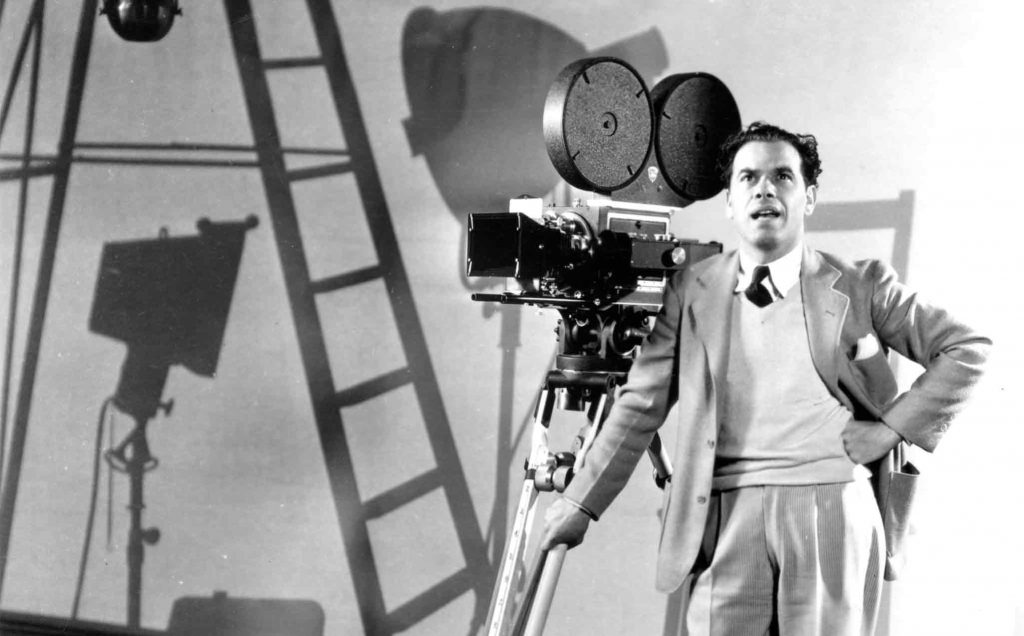Films like, “Mr. Deeds Goes to Town,” “Mr. Smith Goes to Washington,” and “It’s a Wonderful Life” have been enjoyed by American audiences for decades and have pulled at the heartstrings of their audiences. What do all of these famous films have in common? They were all directed by Frank Capra. Capra was one of the most famous and successful movie makers in Hollywood in the 1930s and 1940s.1 The question that must be asked is simply this: What was it about Frank Capra’s films that made them so popular among the American people during a time of extreme economic crisis? Capra was known for making films about the common man in a small town, surrounded by a world of corruption. It was in Capra’s films that Americans living through the turmoil of the Great Depression could find an escape from the harsh reality they faced everyday.2

Frank Capra was born in Sicily in 1897 and was relocated to the United States with his family in 1903. He attended the California Institute of Technology, where he studied Chemical Engineering and graduated in 1918.3 Following his graduation, Capra enlisted in the United States Army and taught math to artillerymen at Fort Point, San Francisco. Shortly after Capra left the army he began working for Mack Sennett Studios. It was here that he learned the ins and outs of writing as well as directing. The knowledge he obtained here led to him taking a position with Columbia Pictures in 1928.4 Columbia Pictures became Capra’s home. It was here that he would produce the films that would sell his great vision of the right society that appealed to so many Americans.
In October 1929, the stock market in the United States crashed and the Great Depression followed.5 America experienced the longest and hardest economic contraction in its history. Due to this crash, a massive downturn in consumer spending ensued and, as a result, businesses began letting go of employees in massive numbers. The individuals who were fortunate to stay employed saw dramatic decreases in their pay.6 Families were struggling, literally living paycheck to paycheck. The economy America had known was no longer flourishing and the American Dream seemed to many to be a mirage. It may have seemed risky and perhaps even slightly crazy to attempt to produce movies during this time, but that did not stop Frank Capra. Not only did he begin directing movies during the Great Depression, but he produced some of the most successful films of his career. Even though he was not born in America, Capra was intensely patriotic and he believed that America was the land of opportunity. He also believed it was not the corporation, but the individual, who defined America, and was once quoted as saying that the American people were “each an island of human dignity.”7 It was this image of the American individual that he strove to depict in his films.
Prior to the Great Depression, America was a country seeing everything presented in mass; mass thought, mass production, mass education, mass politics, mass wealth and mass conformity. Capra was looking to help Americans rid themselves of this mindset. He stated that his films “embodied the rebellious cry of the individual against being trampled into an ort by massiveness.”8 He knew that he brought a sort of romantic populism to his films and he wanted his audiences to find solace in this romanticized vision of America.9 Even with the economy in a downturn, people of this era still found the time and money to enjoy going to the movies. At the time, movies were one of the few affordable means of entertainment and they acted as an escape from reality into a more ideal world. Capra’s movies mainly focused on men from small towns who had a strong distaste for the cities around them, and their quest to reform their community.

In Capra’s film, “Mr.Deeds Goes to Town,” an ordinary man by the name of Longfellow Deeds comes into a large inheritance and is forced to fend off greedy individuals who are after his money. After spending time in court where a greedy lawyer tries to take advantage of him, Deeds moves back to his small town and gives his inheritance to the less fortunate people in the town.10 In “Mr. Smith Goes to Washington,” a small town man, Jefferson Smith, is elected to the U.S. Senate and finds himself exposing the corruptness and selfishness of his colleagues. Of the countless movies that contain the same themes, these are two examples of Capra’s portrait of the typical American: living in a small town trying to make their way in the world, only to be confronted with greed and corruption.11 In one of Capra’s most famous and iconic films of all time, “It’s a Wonderful Life,” the main character, George Bailey, is depicted as a small town man that endures the hard reality of bank closure during the Great Depression. Bailey is nearly destroyed by a greedy banker, and is given a glimpse of what his life would be like had he never existed. Throughout the film, Bailey sees the numerous impacts he has had on the lives he has encountered. Bailey wakes up, coming to the realization that despite all the negative things that have occurred throughout his lifetime, the life he has been given is truly a wonderful life.12

Of all the films Frank Capra wrote and directed, they all share a common theme. Each film depicts compassion towards the common American and shows that when people work hard and hold together, they are able to help not only themselves, but one another. Capra’s films gave the American people a sense of pride for themselves and for their communities. Capra gave the viewers a character to relate to, and therefore lent support for their problems. So, what was it about Frank Capra’s films that made them so popular among the American people during a time of such extreme economic crisis? The answer is quite simple: empathy. Capra had a gift for disguising the social, political, and economic problems presented by the Great Depression and gave the people something they had lacked: hope.
- Alan Brinkley, American History: Connecting with the Past Volume 2, 15 edition (McGraw-Hill Education, 2014), 653. ↵
- John Marini, “Capra’s Quest,” USA Today Magazine, July 2015, 31. ↵
- John Marini, “Capra’s Quest,” USA Today Magazine, July 2015, 29. ↵
- Funk & Wagnalls New World Encyclopedia, 2016, s.v. “Frank Capra.” ↵
- Salem Press Encyclopedia, 2015, s.v. “U.S. Stock Market Crashes,” by Daniel Y. Lee. ↵
- Brinkley, American History: Connecting with the Past, 644-645. ↵
- Brinkley, American History: Connecting with the Past, 653. ↵
- John Marini, “Capra’s Quest,” USA Today Magazine, July 2015, 30. ↵
- Brinkley, American History: Connecting with the Past, 653. ↵
- “Mr.Deeds Goes to Town,” directed by Frank Capra (Time-Life Video, 1936), DVD. ↵
- “Mr. Smith Goes to Washington,” directed by Frank Capra (Columbia Pictures, 1939), DVD. ↵
- “It’s a Wonderful Life,” directed by Frank Capra (RKO Radio Pictures, 1946), DVD. ↵



40 comments
Kelly Arevalo
Good article! I haven’t had the opportunity to watch any of these movies, however, thanks to what you mentioned in your article, I can see how important Capra’s films were for the American population during those years. Great job!
Javier Oblitas
I hadn’t known the genre of comfort films had been most likely popularized due to Capra’s work to bring the American morale up! Nor that working hard and compassion had not been a common theme in movies at the time! It showed the American audience a introspective look at empathy. It was very interesting to find out despite studying Chemical Engineering he had became a film engineer and goes to show anyone can do it with enough hard work!
Jadyn Evans
I have always adored the movies, “it’s a wonderful life” and “Mr.Deeds goes to town”. They have always been my sort of comfort movies. I never knew about the creative mind who directed these masterpieces. Even though that Frank Capra was not born American I like how he wanted to show to Americans during one of the worst times that life can still be full of joy. The themes that he expresses in his movies are uplifting to an audience who have lost so much.
Elizabeth Santos
“Mr.Smith Goes to Washington” was such a fun and educational watch! It’s always interesting to learn about the man behind the idea, and intriguing to understand the inspiration behind it. Capra truly did have the gift of taking off tensions from the real world, by giving some more optimism and nurturing the sense of community. Not only was there a sense of community, but empathy, humor, and an overall wholesome feeling. Frank Capra deserves more recognition!
Nicholas Burch
Frank Capra does a great job of showing the audience something they can truly feel. Every director’s main goal is to make their audience feel emotion but in the 1940s, when things weren’t going so well in America, Capra was one of the few directors giving his audience something they actually needed. With everything going on in America today, there aren’t many movies being made. It would be nice if Frank Capra were still alive today because he’s pretty great at giving America hope.
Lesley Martinez
Frank Capra’s commitment to direct films during the Great Depression is captivating. It’s interesting to read that Capra went to school to study Chemical Engineering and ended up becoming a film director. This truly proves that it is never too late to start a new career or hobby. Capra’s patriotism to the United States and ambition to change the stereotypes that rose during the 1930s into compassion toward a united America is incredible. Great article!
Mitchell Yocham
To me and to many Capra’s work was incredibly special because it gave us so much empathy. His work showed that common theme of the average person, that way so many people were able to relate to all of his films. To me not only in movies but for the theatre as well, empathy is a big part of everything and when someone has empathy that means that they can connect to it and it’s a good film.
Michael Lazcano
Capra is definitely a name you know if you’re interested in the film medium, and his films are influential all around the world. The American film industry especially was influenced by his films and how he portrayed the ideal way of American life, this made people link the idea of the “American Dream” with his films. The average person is someone we can all sympathize with because we all face troubles, we all go through hardships, we are all for the most part common folk. In the time of economic devastation he provided hope for everyone who thought living a wonderful life wasn’t possible.
Antonio Coffee
I have always loved “It’s a Wonderful Life” but I never knew anything about the man who made the movie. Capra has had a huge influence on American culture and I think he deserves more recognition than he is often given for the impact he had on America through his films. His films seem to not just show the idea of empathy like the author mentioned but also the idea of the American Dream. It embodies the idea that one can make a difference no matter what they face.
Christopher Metta Bexar
Being a large fan of cinema I had of course heard of Frank Capra the brilliant director, but very little of Frank Capra the man. It was good to hear about the man behind the creation.
So many millennials might never realize that a director might be working on two or three movies at the same time ( in fact one director is the credited director of two of the oscar nominees for best picture of 1939. He directed them at the same time rushing from one to the other). Capra always seemed to be working on his next project while involved in the current one.
Again, it was interesting learning about Capra the man. I enjoyed the article.